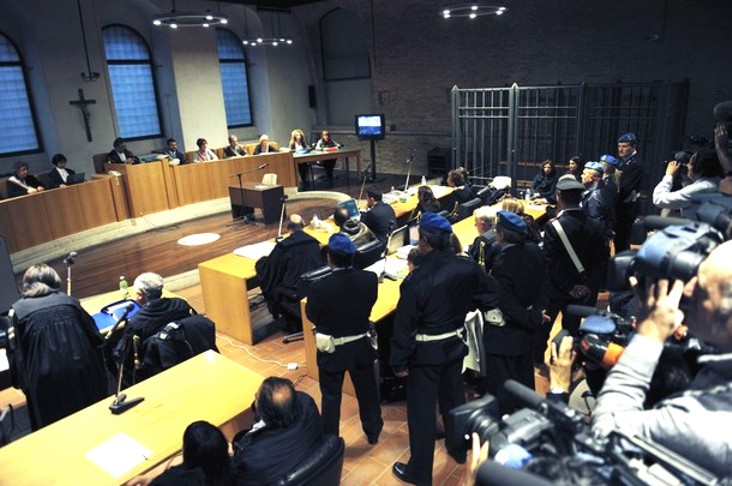
Friday, December 04, 2009
The Rulings: The Families And The Media Have Been Summoned To The Courtroom
Posted by Peter Quennell
The as-usual impartial Ann Wise reports for ABC News.
An Italian court deliberating the fate of Amanda Knox has summoned the defendants and lawyers to the courtroom in what may be a verdict in the nearly year-long murder trial.
The long awaited verdict may be delivered when court resumes at midnight in Italy [6 p.m. ET] after the defendants, lawyers and their families—as well as the family of murder victim Meredith Kercher—arrive at the court in this medieval town.
If convicted of murder, Knox, 22, and her co-defendent and former boyfriend Raffaele Sollecito, 25, could be sentenced to life in prison.
The announcement of a verdict came 11 hours after the six jurors and two judges began their deliberations this morning, and 11 months after the prolonged trial began.
The last 24 hours have been tense for Knox whose younger sister Deanna told ABC News that Knox was torn between excitement about the prospect of going home for Christmas, but scared that she would be convicted and sentenced to life in prison.
This we believe will be the first time Meredith’s family has ever had to encounter the Knoxes and the Mellases. They have seen Amanda Knox in court several times, and it was once noted that Knox seemed to stare fixedly at them, perhaps hoping for eye contact.
And below, translated by our poster Tiziano, is a an article in Il Messagero today explaining what the judges and lay-judges are going through,
The Court of the Assizes is called upon at this time to undertake a very difficult task, and frankly this writer feels compelled to express his understanding of the difficulty within which the judges will have to operate. Furthermore, the function of the Court of the Assizes is linked to the examination and the decision-making on trials which have a notable social profile in relation to the crime for which the judgement arises.
As is known, the Court of the Assizes is composed of a president and an assistant judge (a “side judge”: trsl.), both of whom are stipendiary (=career) magistrates, and of a full six civil judges, chosen from those who have matriculated from high school (ie: who are qualified for university entrance), who have full civil and voting rights and who are between the ages of 30 and 65.
The ambit of the Court of the Assizes is a very special jurisdiction, which our order imported from the French law: the term “assise” was already noted in the medieval epoch with the French word “asise”, that is to say, “a fixed article”, which in its turn derived from the latin “assidere”, that is, “to seat next to”. It was only in 1810 that the French order introduced “le cour d’assises”. In the Italian order the Court of the Assizes appeared in 1859, in the Sardinian penal procedures code, until in alternate phases, it found a new place in the reform of the judicial order which came into force in 2003.
Briefly, it is competent to decide on all those crimes for which the law sets out a penalty of life imprisonment or a penalty of not less than 24 years. In the Kercher judgement, therefore, the decision will be in the hands of two career judges (“robed judges”: trsl.) and six civil judges, who will have the difficult task of evaluating even complex technical legal questions. The worth of the vote of the civil judge is equal to that of the career judges, thus substantially each of the eight judges is to be considered equal in grade in the expression of his/her own conviction on the guilt or otherwise of the defendants.
Because of the nature of the structure of the Court of the Assizes , as well as because the circumstances of the Kercher trial are substantially that of a circumstantial trial, it is to be presumed that the deliberations of the panel will be extremely long. On each of these judges weighs the delicate task of having to decide on the future life of two young people, and at the same time, of giving an answer to the thirst for justice of the Kercher family and of society as a whole.
It is not to be excluded that a majority decision will be arrived at, in so far as in these cases, it is arduous to obtain an unanimous one, for in addition to technical reasons, the individualities of each single judge must must prevail, each of whom must be intimately convinced of his or her own choice. There still exists, borrowed from Anglo-saxon law, the border which separates guilt from acquittal, constituted by the principal of a choice made “beyond any reasonable doubt”.
Comments
No comments yet. Commenting is not available in this channel entry.Where next:
Click here to return to The Top Of The Front PageOr to next entry Full Roundup On The Verdict, Sentencing And Reactions Here For Sure Sunday Latest
Or to previous entry The Ruling Deliberations: Updates On Any New Developments Today Friday

